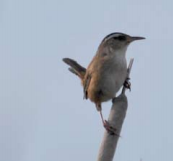There are a group of local waterbirds that even many dedicated river rats are not familiar with. They are secretive denizens of emergent wetlands along the St. Lawrence and Lake Ontario and their tributaries. While some wetland birds, such as Black Tern and Great Blue Heron, are obvious to observers, others are not. These more secretive species include some herons, rails, shorebirds and waterfowl as well as wetland songbirds. Most often they are only detected by sounds uttered or when flushing and flying reluctantly for short distances before dropping back into the marsh. These interesting but little known birds are a challenge for people to become familiar with.
As the large wetlands of our region become ice-free in spring, early breeders return. The earliest arrivals tend to be hardy waterfowl species such as Wood Duck and Hooded Merganser. The habits of spring waterfowl, particularly courtship antics, make them far more obvious to us than other birds arriving close behind. Evidence suggests that rails such as the Virginia Rail and Common Gallinule arrive by mid-April. They are often silent for another 2-4 weeks making them difficult to detect. Even among birds, that as group are well studied, rails remain a bit of an enigma even to experienced observers.
Our one local breeding grebe species, the Pied-billed, often returns by late March but may remain quiet for a while. Once they commence the loud territorial mating call proclaiming ownership of their piece of marsh they are hard to miss. Often mistaken for a small duck when seen, their ringing COW COW COW call is unique. Once much more common this species has declined greatly in the last half-century. A major adverse factor locally has been previous water level management regime that affected the cattail/sedge meadow to open water rationing of the marshes. Hopefully the new regime of Plan 2014 will greatly improve this situation.
Our most frequent wetland shorebird is the Wilson’s Snipe. This species may use even small pothole type wetlands. Usually detected by the winnowing sound made by its wing feathers during courtship displays, the male may be seen circling high above its breeding territory. This performance to attract a mate is spectacular and well worth spending a few minutes watching. It is most often performed between early April and mid-June during the height of the breeding season.
Three regular species of the enigmatic rail clan occur in our wetlands from April to October. These are the Virginia Rail, Sora and Common Gallinule. A fourth species, the King Rail, occasionally wanders this far north. These denizens of deep wet vegetation are rarely seen but often heard, All have distinctive territorial songs and calls that announce their presence from May to July. Once ceasing calling they disappear into their watery realm until the following spring. Even during migration, most reports by birders are a result of rails colliding with structures or other causes of mortality.
The large Great Blue Heron is one of the most familiar birds to river rats everywhere. While this species does feed in emergent wetlands it does not nest there. Some of the Great Blues smaller cousins are among the interesting secretive birds of wetland communities. My favorites are the bitterns, American and Least. The first standing half as tall as a Great Blue and the latter capable of fitting in an oversized coat pocket. Both are masters of camouflage being excellent at hiding in plain sight, Often “freezing “ with neck and head extended straight up their cryptic coloration gives them a remarkable resemblance to surrounding marsh vegetation.
As with many marshland species there is nothing cryptic about their vocalizations. While the Least makes a distinctive COO COO COO, similar to a Black-billed Cuckoo, appropriate to its size the American’s sound will blow you away. Colloquially known as “Thunder Pumper” this species territorial “song” is extraordinary. By filling its chest cavity with air, released as part of the performance, the male creates a sound that can be heard for great distances. The words unk ka chuonk repeated several times is the best representation I can manage. Once heard this call will never be mistaken for anything else. It sounds like a stake being pounded into the marsh. Having observed male American Bitterns delivering this performance my impression is that they look about to explode. Clearly though it works for their lady love and, although declining, the species persists.
While many species of songbirds use large coastal wetlands, few are obligate breeders in such habitat. One of the best examples is the Marsh Wren. This specialist relative of the familiar House Wren arrives on the River in late April. During the breeding season, its staccato song reverberates through the cattails. These jaunty little birds often sing from atop stalks of wetland plants thus they are easier to see than many marsh dwellers. Also bolder than many birds that inhabit the marshlands they will often permit a fairly close approach by canoe or kayak. Other species of songbirds such as Swamp Sparrow breed in this habitat but they are not restricted to it.
The ecological value of wetlands to a myriad of life forms has been documented for decades. Preserving all existing wetlands large and small while attempting to restore those damaged by ignorance of previous generations is essential. Once considered wastelands we have learned that they are essential to the web of life on this planet. To quote from a late governor and senator from Florida, "My granddaddy tried to drain the Everglades I am trying to restore them”. We should seek to do as well for local wetlands drained for agriculture and other purposes.
Written by Gerry Smith, Consulting Ornithologist.






